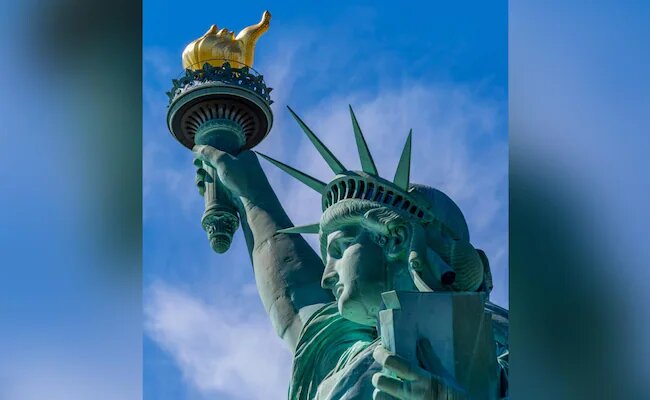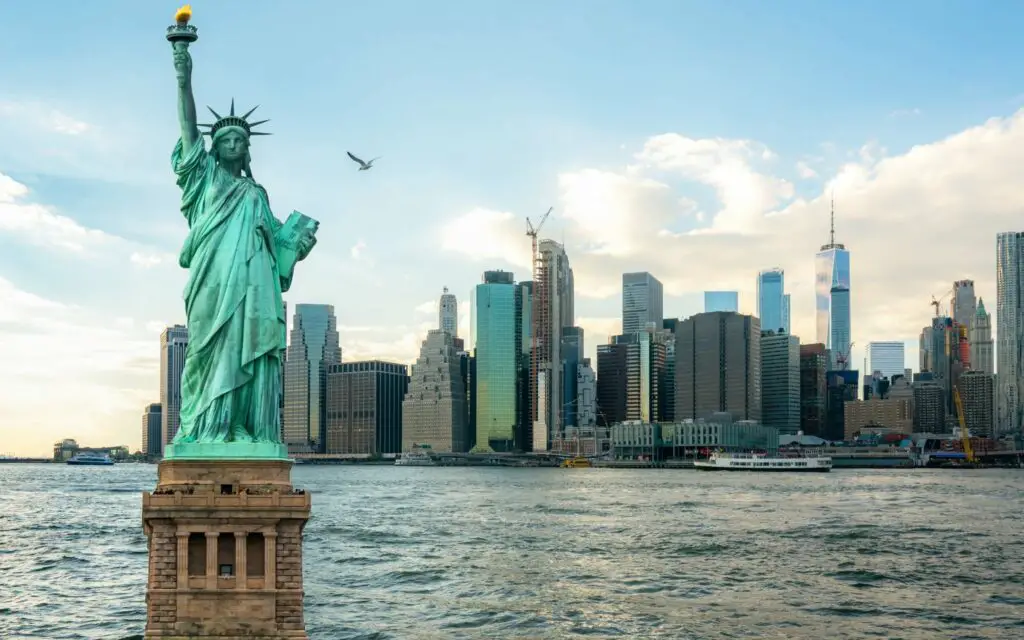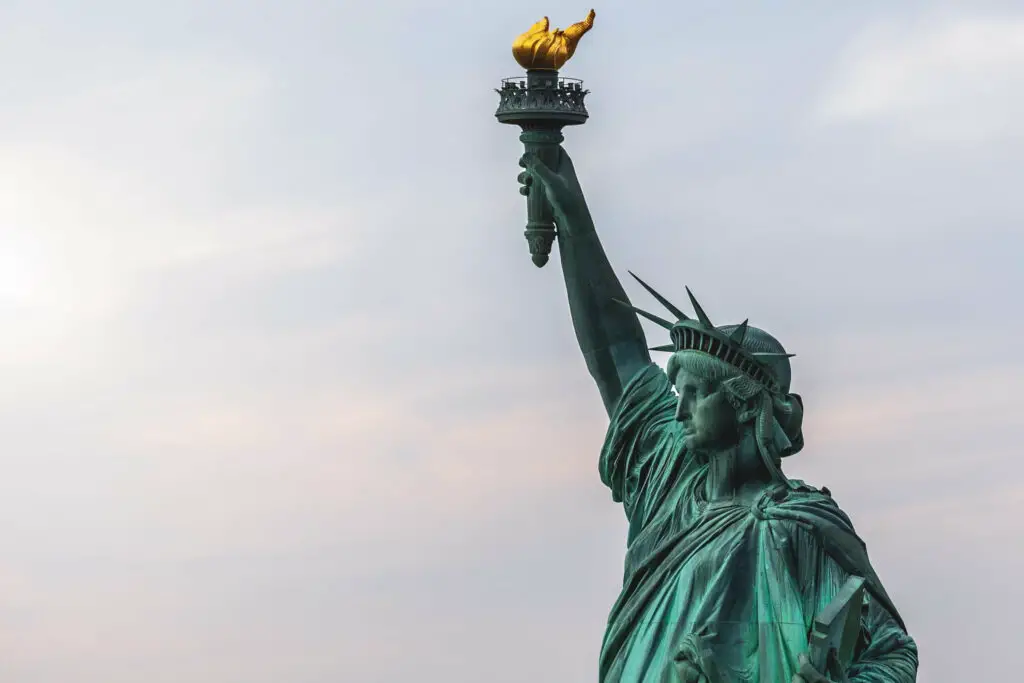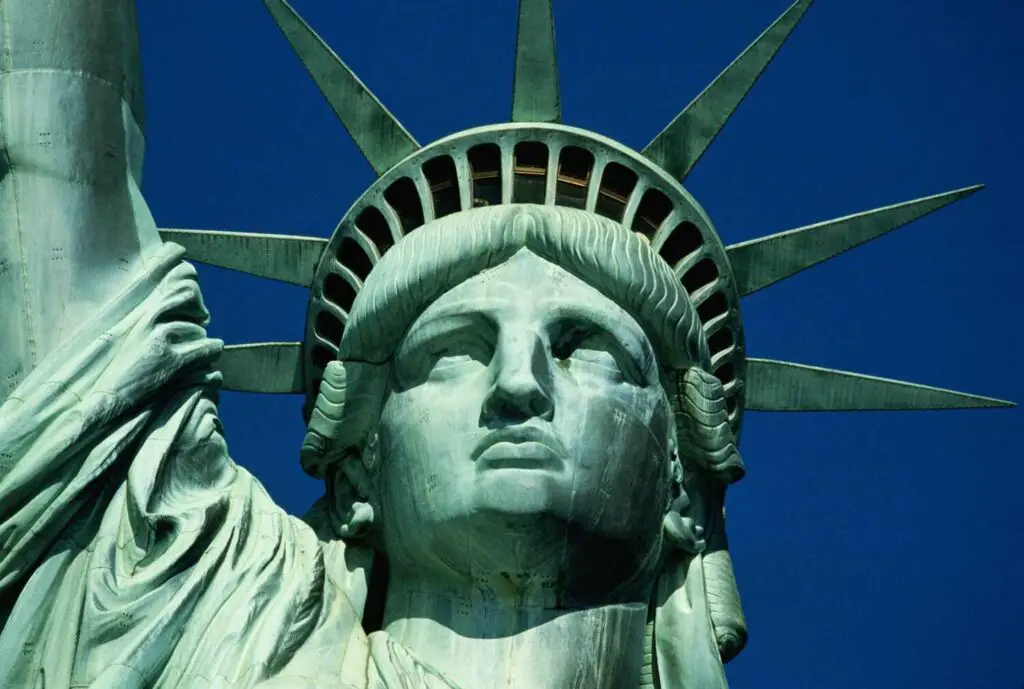Eternal Flame: Unveiling the Statue of Liberty

Introduction
The Statue of Liberty stands as an iconic symbol of freedom and democracy, its torch held high as a beacon of hope for generations of immigrants. Designed by the visionary French sculptor Frédéric Auguste Bartholdi and dedicated on October 28, 1886, this majestic statue has become an enduring emblem of the United States of America. Situated on Liberty Island in New York Harbor, it welcomes millions of visitors each year, serving as a reminder of the nation’s commitment to liberty and justice for all.
Bartholdi’s inspiration for the Statue of Liberty stemmed from his admiration for the principles of freedom espoused by the United States, as well as his desire to commemorate the Franco-American alliance forged during the American Revolution. Collaborating with the esteemed engineer Gustave Eiffel, Bartholdi brought his grand vision to life through meticulous planning and innovative construction techniques. The result was a monumental statue that not only captured the imagination of the world but also embodied the ideals of liberty and democracy.
As we delve into the history, symbolism, and cultural impact of the Statue of Liberty, we uncover the profound significance of this cherished monument and its enduring legacy in shaping the American identity.
The Vision of Frédéric Auguste Bartholdi

Frédéric Auguste Bartholdi, a renowned French sculptor and artist, conceived the idea for the Statue of Liberty as a tribute to the shared values of freedom and democracy between France and the United States. Inspired by the principles of liberty championed by the American Revolution, Bartholdi envisioned a colossal statue that would serve as a symbol of hope and enlightenment for people around the world. His passion for the project was fueled by a desire to honor the Franco-American alliance and celebrate the enduring spirit of democracy.
Collaborating with the acclaimed engineer Gustave Eiffel, Bartholdi embarked on the monumental task of bringing his vision to fruition. Together, they designed a groundbreaking structure that combined artistic elegance with engineering ingenuity. Eiffel’s expertise in metalworking proved invaluable in creating the statue’s framework, while Bartholdi’s artistic vision breathed life into the monumental sculpture. Through their collaborative efforts, they transformed Bartholdi’s dream into a tangible symbol of freedom that would inspire generations to come.
The construction of the Statue of Liberty posed numerous challenges, from fundraising obstacles to logistical hurdles. Despite facing setbacks and delays, Bartholdi remained undeterred in his mission to complete the project. With unwavering determination and the support of dedicated supporters on both sides of the Atlantic, he overcame adversity and successfully realized his vision. On October 28, 1886, the Statue of Liberty was officially unveiled to the world, marking a historic moment in the annals of American history.
Construction and Installation

The construction of the Statue of Liberty was a monumental undertaking that required meticulous planning, innovative engineering, and unparalleled dedication. Bartholdi’s vision for the statue was brought to life through a combination of traditional sculpting techniques and cutting-edge metalworking methods. Gustave Eiffel, renowned for his expertise in structural engineering, played a crucial role in designing the statue’s framework, which consisted of a series of iron supports that formed the skeleton of the monument.
Funding for the construction of the Statue of Liberty was raised through a combination of public and private donations, both in France and the United States. In addition to individual contributions, the French government provided significant financial support for the project as a symbol of Franco-American friendship. Fundraising efforts were spearheaded by influential figures on both sides of the Atlantic, including newspaper publisher Joseph Pulitzer, who launched a successful campaign to raise funds for the pedestal on which the statue would be mounted.
Transporting the Statue of Liberty from France to the United States was a logistical feat of epic proportions. The statue was disassembled into more than 300 individual pieces, which were then packed into more than 200 crates for shipment across the Atlantic. Upon arriving in New York Harbor, the statue’s components were carefully reassembled on Liberty Island, where it was mounted on a massive pedestal overlooking the city skyline. The installation of the statue marked the culmination of years of planning and hard work, symbolizing the enduring bond between France and the United States.
Symbolism and Meaning

The Statue of Liberty is rich in symbolism, with each element carefully chosen to convey its message of freedom and democracy. At the heart of the statue is the torch, held high as a beacon of hope and enlightenment for all who seek refuge on America’s shores. The torch symbolizes the eternal flame of liberty, illuminating the path to a brighter future for generations to come.
Another prominent feature of the statue is the crown, adorned with seven rays representing the seven continents and seven seas of the world. This symbolizes the universal appeal of liberty, transcending national boundaries and uniting people from all walks of life.
The tablet held in the statue’s left hand is inscribed with the date of American independence, July 4, 1776, symbolizing the enduring legacy of the nation’s founding principles.
Additionally, the broken chains at the statue’s feet serve as a powerful reminder of the struggle for freedom and the triumph over oppression. These symbols collectively embody the spirit of liberty and serve as a testament to the enduring values that define the American identity.
Cultural Impact

Since its unveiling in 1886, the Statue of Liberty has left an indelible mark on the cultural landscape of the United States and the world at large. As a symbol of freedom and democracy, it has inspired countless artists, writers, and activists to reflect on the ideals of liberty and justice.
The statue’s iconic silhouette has been featured in numerous works of art, literature, and popular culture, serving as a powerful visual shorthand for American values. From paintings and sculptures to films and television shows, the Statue of Liberty has become synonymous with the spirit of freedom and the promise of a better tomorrow.
Moreover, the statue has served as a powerful symbol of welcome and acceptance for immigrants arriving in the United States. For millions of people around the world, the sight of Lady Liberty standing tall in New York Harbor represents the fulfillment of their dreams and the promise of a new beginning.
In today’s increasingly interconnected world, the Statue of Liberty continues to resonate with people of all backgrounds, inspiring hope and optimism in the face of adversity. Its message of liberty and equality remains as relevant today as it was over a century ago, reminding us of the enduring power of freedom to unite and uplift humanity.
Restoration and Preservation Efforts

Over the years, the Statue of Liberty has undergone numerous restoration and preservation efforts to ensure its longevity for future generations. Exposure to the elements, environmental factors, and general wear and tear have taken their toll on the statue, necessitating periodic maintenance and repairs.
One of the most significant restoration projects took place in the 1980s, in preparation for the statue’s centennial celebration in 1986. The project involved a comprehensive overhaul of the statue’s exterior, including the replacement of corroded copper panels and the reinforcement of its internal structure. Skilled craftsmen meticulously restored the statue’s verdigris patina, carefully preserving its iconic green hue while removing decades of grime and corrosion. The restoration effort was a testament to the dedication and craftsmanship of the artisans involved, who worked tirelessly to ensure that the statue would shine brightly for generations to come.
In recent years, ongoing preservation efforts have focused on addressing the effects of climate change and sea-level rise on Liberty Island. Measures such as shoreline stabilization and flood mitigation have been implemented to protect the statue and its surrounding infrastructure from the threat of erosion and storm damage. Additionally, advanced monitoring systems have been installed to track changes in the statue’s condition over time, allowing conservationists to identify and address potential issues before they escalate.
Despite these challenges, the Statue of Liberty remains a resilient symbol of freedom and resilience, standing as a testament to the enduring spirit of the American people. Through ongoing restoration and preservation efforts, we ensure that this iconic monument continues to inspire and uplift future generations, reminding us of the timeless values of liberty, equality, and justice for all.
Conclusion

As we reflect on the rich history, symbolism, and cultural impact of the Statue of Liberty, we are reminded of its enduring significance as a beacon of freedom and democracy. From its humble beginnings as a gift from the people of France to its iconic status as a symbol of hope for immigrants around the world, the statue has captured the imagination of millions and left an indelible mark on the American landscape.
Designed by the visionary French sculptor Frédéric Auguste Bartholdi and dedicated on October 28, 1886, the Statue of Liberty stands as a testament to the enduring bond between France and the United States. Bartholdi’s grand vision, realized through the collaborative efforts of engineers, artisans, and philanthropists on both sides of the Atlantic, serves as a powerful reminder of the universal appeal of liberty and democracy.
Over the years, the statue has weathered countless storms, both literal and metaphorical, yet it remains as resilient as ever, standing tall in New York Harbor as a symbol of hope and resilience. Through ongoing restoration and preservation efforts, we ensure that this iconic monument continues to inspire and uplift future generations, reminding us of the timeless values of liberty, equality, and justice for all.
As we look to the future, let us reaffirm our commitment to upholding the ideals embodied by the Statue of Liberty – ideals that transcend borders, unite nations, and inspire humanity to strive for a better tomorrow. In doing so, we honor the legacy of those who came before us and pave the way for a brighter, more inclusive world for generations to come.


